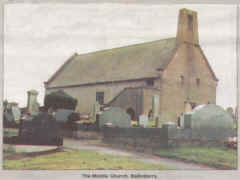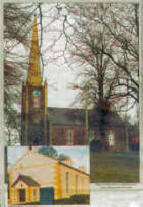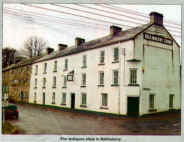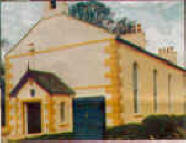
Ballinderry - a very pretty place to be
This week Neill Greenlees looks at the history of Ballinderry
 OH! 'tis pretty to be in Ballinderry according to the
well known traditional poem which tells of a local girl's doomed love for one Philemy Hyland.
OH! 'tis pretty to be in Ballinderry according to the
well known traditional poem which tells of a local girl's doomed love for one Philemy Hyland.
But in more recent times many people have also found the Ballinderry area a pretty place to live as demonstrated by the large number of smart new homes which have been constructed in the area.
However, many of these people may not realise just how much history lies behind `the town of the oakwood' which is located eight miles west of Lisburn towards the shores of Lough Neagh. There can be little doubt the road which leads from Lisburn to the loughshore and which is bisected by the main route from Nutts Corner to Moira Roundabout is one of the most pleasant and scenic in the borough.
Ballinderry Road runs through a mature settled landscape of strong trees and enclosed fields towards the Portmore area.
Settlement of this land can be traced back almost 1000 years and its ecclesiastical connections go back even further.
Local historian Anne Stevenson knows a great deal about Ballinderry's past and her findings certainly present some fascinating facts.
For example, from the 17th century onwards the parish of Ballinderry was part of the Conway Estate. This was later known as the Hertford Estate and the title subsequently passed into ownership of the Wallace family.
 The first Lord Conway was Edward, the brother of Fulke Conway who had been granted the lands by James the First.
The first Lord Conway was Edward, the brother of Fulke Conway who had been granted the lands by James the First.
They stretched from east of Lisburn to the shores of Lough Neagh.
Indeed, Sir Fulke had a castle in Lisburn, the site of which is now Castle Gardens, and at the furthest extremity of his estate which was Portmore he built a second castle as a rural retreat,
Anne explained Sir George Rawdon of Moira was Fulke's brother in law and also his land agent.
Together, the two men worked on many projects to benefit the Conways' tenants.
Stoked
The townland of Deerpark near Portmore Castle was kept stocked with deer and game for hunting and it was in this area a dramatic incident occurred around 1760.
"A huge oak tree was blown down;" explained Anne.
"The circumference of the tree was 42 feet and the lowest branch was 25 feet up from the ground.
'It is said a single branch sold far £9, the stem for £97 while the main parts of the remainder were sold for £30 out of which was built a 40 ton ship.
"Many articles of furniture were made locally from this tree which was reputed to be 1400 years old."
A drive from Lisburn to the heart of Ballinderry will take motorists past some of the most historic buildings in the area.
Lissue House was built around 1807 and was owned by the Lisburn linen family the Richardsons until well into this century.
In 1941 its owner Colonel Lindsay offered it to the Belfast Hospital for Sick Children as a refuge from the air raids on the city.
In 1947 the house was bequeathed to the hospital and was used as a childrens convalescent home until 1988.
In 1831 the present Magheragall Parish Church was consecrated by Bishop Mant having replaced at a cost of £1000 one built on the site in 1676.
Called
However, the church bell which called people to worship in 1676 is still in use and Holy Communion is celebrated using a chalice dated 1705 and two patens dated 1769.
The well known musician Sir Hamilton Harty was appointed organist and choirmaster at the church on February 12, 1884 at the age of just 14.

Another well known site at Ballinderry :Crossroads is Ballinderry Antique Shop.
This has been an antique shop for around 40 years but originally was constructed around 1700.
It began as a staging post for horse drawn coaches taking the ancient road from Dublin to -Antrim.
This is now the A26 and was realigned at Ballinderry in the 1950's
At various times in the past the building was a grain store, a bottling store and a bicycle shop.
There are two Church of Ireland places of worship in Ballinderry - the Middle Church and the Parish Church.
The Middle Church was built under the direction of Jeremy Taylor, Bishop of Down and Connor and Dromore from 1661.
He had served as a Chaplain with the Royal Army during the English Civil War and to avoid imprisonment was brought to the Lisburn area by Lord Conway.
The construction work began in 1665 and the church was consecrated in 1668.
Similar
It is similar to non-conformist churches of the period having straight high backed pews made of Irish oak and a centrally placed three tier oak pulpit.
"There is a local tradition the huge pew opposite the pulpit was reserved for Lord Conway and the graveyard is still the graveyard for the parish,"
explained Anne.
"Although not in regular use throughout the year because it has no artificial light or heating, the Middle Church is used for services at Easter and
Christmas as well as occasional Evening Prayer during the summer months and baptisms, weddings and burials."
The present Ballinderry Parish Church was erected in 1824 at a cost of £2,200 of which £1000 was provided by the Marquis of Hertford and the remainder by the parishioners.
"The church spire is 128 feet in height and the stained glass window was erected in 1862 by Thomas Walkington of Oatland Cottage, Ballinderry
in remembrance of his father and mother and in pious memory of his ancestor Edward
Walkington, Bishop of Down and Connor in 1695 " explained Anne.
At the front of the gallery is a large painting of the royal coat of arms of Charles II which was brought from the Middle Church in 1859 and may have originally hung at Portmore Castle in the 17th century
Site of one of province's Moravian congregations
ONE of Northern Ireland's five Moravian congregations is located in Lower Ballinderry. The congregation owes its origins to the Moravian evangelist John Cennick who arrived in Dublin in 1746 and had established a church in the city by 1749.
He was invited to preach 'the word of life' by a group of businessmen from the North.
On October 5,1750 Cennick preached at a spot in Ballinderry known as the 'cock fighting pit'.
The following year people who had been inspired by his words expressed a wish to establish a Moravian church in the village.
The piece of land where Cennick had preached was rented and the church erected.
 The building was opened for worship on Christmas Day,1751.
The building was opened for worship on Christmas Day,1751.
However, it was not until 1755 the Moravian Society of Ballinderry which had around 150 members was formed into a congregation along with Kilwarlin and Glenavy.
Brother Syms was appointed Minister and in the same year the church leased an adjoining piece of land as a burial ground from a Mr. Benjamin Haddock.
The service to mark and recognise Ballinderry as an official congregation was conducted by Brother John de Waterville a Bishop who is still remembered annually for the introduction of the Christingle used by all Moravians and many other denominations today.
The years which followed were not without problems for the Moravians of Ballinderry.
During the months of October and November 1788 a mob collected for several successive nights and attacked their homes.
In 1776 both single brethren and single sisters moved to live in Gracehill.
The single sisters decided to make their journey by boat across Lough Neagh - a distance of about 10 miles - and boarded a barge on October 10.
However, half way across the vessel sprang a leak and both they and the sailors feared they were doomed.
Fortunately, the weather was calm and by a combination of throwing their heaviest luggage overboard and constant bailing they managed to reach the nearest shore.
The congregation celebrated its jubilee in 1805 but just 30 years later the church and the adjoining dwelling houses were destroyed by fire.
Enough money was raised during 1836 to start re-building with the church being reconsecrated on June 19.
The last Resident Minister Rev T. Stinton left the church in 1921 and ministers have since been shared with Kilwarlin, Cliftonville and Gracehill.
The church's bicentenary celebrations took place on July 24 and 25 1955 and were combined with commemorations of the 200th anniversary of the death of John Cennick.
The church was filled with local people and the special preacher was a former Minister Rev. R.S. Farrar.
| Melody | Ballinderry |
| 1.'Tis pretty to be in
Ballinderry, Pretty to be in Aghalee 'Tis prettier to be on bonny Ram's Island A-sitting forever beneath a tree. Refrain: |: Ochone, ochone. :| 2. For often I sailed to bonny Ram's Island, Arm in arm with Phelim, my love. He would whistle and I would sing, And we would make the whole island ring. Refrain: |
3. "I'm
going," he said, "from bonny Ram's Island Out and across the deep blue sea, And if in your heart you love me, Mary, Open your arms at last to me." Refrain: 4. 'Twas pretty to be in Ballinderry But now it's as sad as sad can be, For the ship that sailed with Phelim, my love, Is sunk forever beneath the sea. Refrain: |
